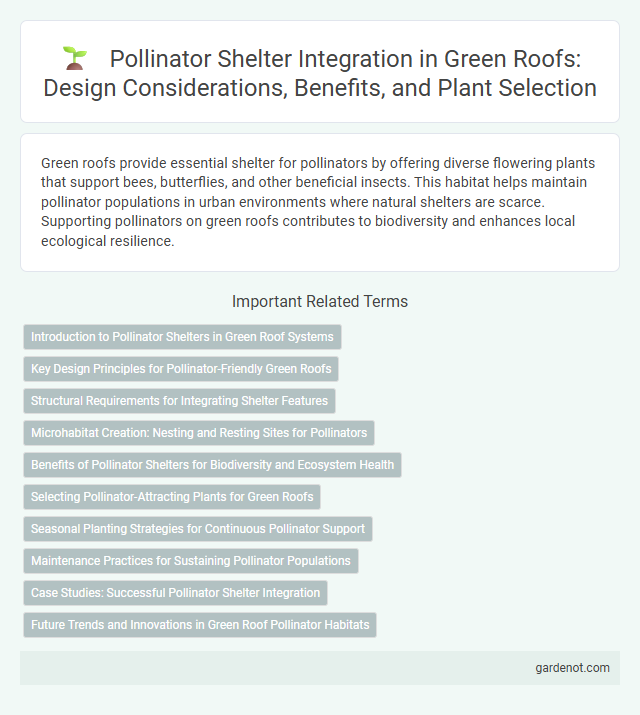Green roofs provide essential shelter for pollinators by offering diverse flowering plants that support bees, butterflies, and other beneficial insects. This habitat helps maintain pollinator populations in urban environments where natural shelters are scarce. Supporting pollinators on green roofs contributes to biodiversity and enhances local ecological resilience.
Introduction to Pollinator Shelters in Green Roof Systems
Pollinator shelters integrated into green roof systems provide vital habitats for bees, butterflies, and other pollinating insects, enhancing urban biodiversity. These structures offer nesting sites and refuge from predators and harsh weather, supporting pollinator populations critical for ecosystem health. Incorporating pollinator shelters into green roofs boosts pollination services for nearby plants and contributes to sustainable urban environments.
Key Design Principles for Pollinator-Friendly Green Roofs
Pollinator-friendly green roofs prioritize diverse native flowering plants that provide continuous bloom cycles, ensuring consistent nectar and pollen sources. Incorporating varied plant heights and structures mimics natural habitats, offering shelter and nesting sites for bees, butterflies, and other pollinators. Effective irrigation and soil substrates maintain healthy vegetation, supporting robust pollinator populations and enhancing urban biodiversity.
Structural Requirements for Integrating Shelter Features
Pollinator shelters integrated into green roofs require lightweight, durable materials such as bamboo or recycled plastic composites to maintain structural integrity without overloading the roof system. Proper anchoring ensures stability against wind uplift, while modular designs allow for easy installation and maintenance within varying rooftop layouts. Adequate spacing and ventilation must be incorporated to promote pollinator health and prevent moisture buildup that could compromise both the shelter and the green roof substrate.
Microhabitat Creation: Nesting and Resting Sites for Pollinators
Green roofs designed with diverse native plants create essential microhabitats that provide nesting and resting sites for pollinators such as bees, butterflies, and hoverflies. Incorporating features like hollow stems, bare soil patches, and sheltered spaces enhances habitat complexity, supporting species-specific life cycles and increasing urban biodiversity. These microhabitats contribute to sustaining pollinator populations by offering refuge from urban stressors and promoting successful reproduction on green roof environments.
Benefits of Pollinator Shelters for Biodiversity and Ecosystem Health
Pollinator shelters provide vital habitats that support the survival of bees, butterflies, and other beneficial insects, enhancing urban biodiversity and promoting ecosystem resilience. They increase pollination rates essential for plant reproduction, thereby boosting green roof vegetation health and productivity. These shelters contribute to sustaining food webs and maintaining balanced ecosystems within urban environments.
Selecting Pollinator-Attracting Plants for Green Roofs
Selecting pollinator-attracting plants for green roofs involves prioritizing native flowering species that provide abundant nectar and pollen throughout the growing season, such as milkweed, coneflowers, and bee balm. Incorporating a diverse mix of perennial wildflowers and shrubs enhances habitat quality, supporting bees, butterflies, and other beneficial insects in urban environments. Proper plant selection promotes ecosystem resilience, improves green roof biodiversity, and fosters pollination services essential for urban agriculture and green infrastructure sustainability.
Seasonal Planting Strategies for Continuous Pollinator Support
Designing pollinator shelters with seasonal planting strategies ensures continuous nectar and pollen availability throughout the year, supporting diverse pollinator species on green roofs. Selecting a variety of native flowering plants that bloom in early spring, summer, and fall maximizes habitat resources for bees, butterflies, and other pollinators. Integrating perennial wildflowers, grasses, and shrubs tailored to the local climate enhances biodiversity and resilience in urban ecosystems.
Maintenance Practices for Sustaining Pollinator Populations
Maintaining pollinator shelters on green roofs involves regular monitoring of plant health, removing invasive species, and providing continuous sources of nectar and pollen throughout the growing season. Implementing seasonal pruning and avoiding pesticide use supports diverse pollinator populations by enhancing habitat quality and food availability. Employing organic mulches and ensuring appropriate irrigation further sustains the shelter's ecological functions and resilience.
Case Studies: Successful Pollinator Shelter Integration
Case studies of successful pollinator shelter integration demonstrate significant boosts in local biodiversity and pollination rates by incorporating native flowering plants and suitable nesting habitats within green roofs. Projects like the Chicago City Hall Green Roof and Toronto City Hall Pollinator Garden showcase increased populations of bees, butterflies, and other pollinators, enhancing urban ecosystem services and supporting sustainable urban agriculture. These examples highlight the importance of habitat diversity, plant selection, and strategic design to optimize shelter conditions for pollinators on green roofs.
Future Trends and Innovations in Green Roof Pollinator Habitats
Emerging innovations in green roof pollinator habitats emphasize the integration of advanced sensor technologies to monitor microclimates and pollinator activity, enhancing habitat health and sustainability. Future trends also include the development of native plant seed mixes tailored to urban ecosystems, promoting biodiversity and improved forage for bees and butterflies. Modular, lightweight substrate systems are being designed for easier installation and maintenance, optimizing green roofs as effective pollinator shelters in dense urban environments.
Pollinator shelter Infographic

 gardenot.com
gardenot.com